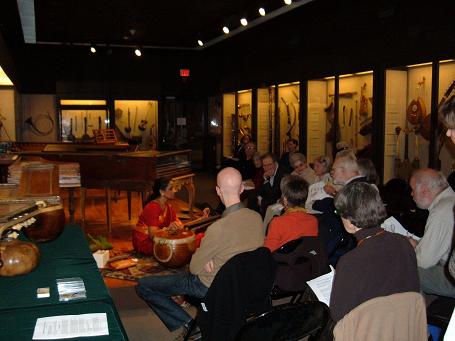Contribute
| Durga Krishnan Presents A Lecture On Origin And Development Of The Veena At The MFA |
Shobha Ramapriya
12/20/2006
Amid the many musical instruments displayed in the showcases of the Musical Instruments Gallary at MFA in Boston, Mrs. Durga Krishnan invited by Mr. Darcey Kuronen (the curator of the instruments) spoke on the Origin and Development of the Veena (India’s national instrument). She played a composition of Muttuswami Dikshitar, Maha Ganapathim, in the raga Natai, talam Adi and introduced the Veena to a spellbound audience of fifty Western musicians.
Krishnan, a Veena teacher for more than three decades and settled in the Boston area, believes that the purpose of her life is now to promote Carnatic Music through Veena, especially in the West for “Westerners are familiar with Sitar, the North Indian stringed instrument while Veena is practically unknown…You even come across advertisements with music from the Sitar in the background,†she noted.
Having done extensive research on the Veena, Krishnan continued to explain that the Veena is the oldest of all Indian instruments. The origin can be traced back to India’s Vedic period. “Originally, there was only one kind of music all over India, but with the invasion of the Moghuls, some aspects of their music got inculcated in the Northern parts and thus rose the bi-classification of North Indian and South Indian music. The South Indian also known as the Carnatic music retains its original form even to this day.
Besides being the most ancient string instrument, Krishnan explained the shape of the Veena from the following different angles…
Spiritually, there are four main strings on the Veena that are pressed and pulled to play the melody and three side strings to provide the drone. Because they are pulled frequently to get the melody, these four main strings go out of tune. The side strings stay pretty much in tune because they are only strummed. They are used as reference in re-tuning the main strings. “This can be compared to the Hindu philosophical concept of the Jeevatman, the individual self, strayed by the Karmic actions as opposed to the Paramatman, the Supreme self that remains changeless,†explained Krishnan.
Mythologically, the story goes that one of the Gods of the Hindu trinity Siva, created Veena upon seeing his wife Parvathi sleeping with her hand across her breasts, hence the shape of the Veena with two globular parts and the finger-board in between.
To most of the Hindus, it is well known that the goddess of knowledge and wisdom, Saraswathi plays the Veena. Ramayana has a reference to the celestial being Saint Narada singing the praises of Vishnu while playing the Veena. It is also a well- known belief that Narada was the one who brought music down to the Earth.
While continuing to explain the Symbolic structure, Krishnan remarked that the Veena is often compared to the human body…Its big bowl (kudam) is like the human head. The finger- board that is connected to the curved end with the dragon or yali is compared to the human spinal column. The 25 frets are compared to the vertebrae and the 25 principles in Yoga. The black wax in which the frets are set is supposedly the illusion that human beings endure. The dragon itself symbolizes the triumph over evil and courage. The pegs or the birudais are the symbol of mind that controls everything.
There are four directions, four seasons, four Vedas and according to the Hindu belief there are four ages, krta, treata, dvapara and kali and the four stages of life, dharma (duty), artha (material gain), kama (love and lust) and moksha (ultimate salvation). The Christianity has the cross that is four sided and there are four gospels, etc. “The Veena has four main strings to symbolize all of the above…and according to the Hindu tradition everything is done three times. For example, the sacred verses are repeated three times. As in Christianity, we have the trinity Brahma the creator, Vishnu the protector and Siva the destroyer. “The Veena’s three side strings can be compared to that concept,†continued Krishnan.
To explain the questioning audience of it’s Scientific approach, Krishnan tilted the Veena showing the Veena’s big bowl totally hollow which allows the sound to resonate and flow through the finger-board to the smaller bowl (kudukai) that works as a resonator. “This end also helps the Veena rest on the lap,†she demonstrated.
The 25 frets on the finger-board set at distances carefully calculated according to acoustic physics to produce the twelve-tone scale that emerged around the 7th century A.D. leaves enough room for the player to put his/her arm around it to press and produce the right notes. The four strings of different thickness and tuned to different notes allow the Veena to have three and a half octaves. The three side strings are strummed at appropriate places to keep control of the rhythm.
The Tanjavur Veena is carved from the Jackfruit tree and ranges from three pieces to one piece. A Rosewood Veena, smaller in size and property of the Museum “is known to be originally made in Karnataka.†The smaller bowl originally made by real squash is now replaced by fiberglass. Today, to suit traveling artists, electronic Veena is also made available.
Concluding the informative talk with a Lalgudi tillana, Durga Krishnan was asked to play the notes on her electronic Veena. Sliding her fingers through both, the electronic and the man-made Veena, Durga Krishnan asked, “which do you think sounds better?â€
For more information go to Durga Krishnan’s website: www.nescm.org.
You may also access this article through our web-site http://www.lokvani.com/

